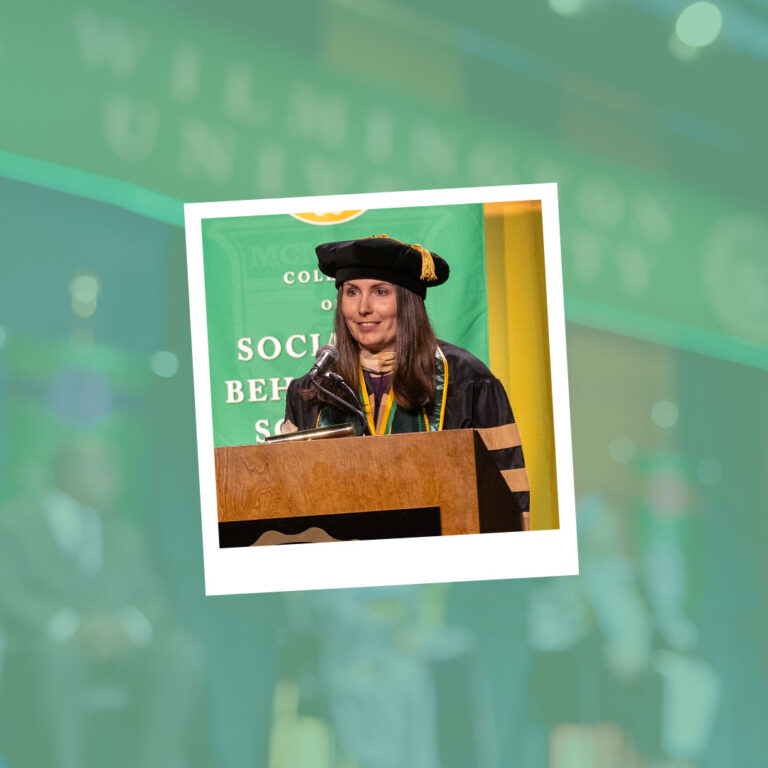Service to the City: Marty Hageman
This alumnus credits WilmU for much of his success as both a police officer and leader of Downtown Visions.

Marty Hageman remembers when Downtown Visions, the management company for Wilmington’s Downtown Business Improvement District, turned on its first surveillance camera 17 years ago. “Within 30 seconds of being activated, it caught a crime being committed,”
he says.
Which could not have been a surprise to him, because if anyone knows the mean streets of Delaware’s largest city and its attendant crime problems, it’s Martin P. Hageman, who also happens to be executive director of Downtown Visions.
The baby in a family of two girls and two boys, Hageman grew up on the city’s West Side and went to St. Elizabeth Elementary School and then Salesianum School. And on his 21st birthday, he was sworn in as a Wilmington policeman, a title he held with distinction for the next 23 years.
“It’s kind of funny,” he says, “because back then I never pictured myself as a police officer. I kind of pictured myself in the military.”
His parents couldn’t afford to send him to college, and when he graduated from Salesianum in 1970, he planned to work through the summer, then enlist in the Army. The Vietnam War was at its height and his father had served in the military.
Then a friend told him about the police academy. “He said the department would pay for two college courses per semester,” remembers Hageman, “and there were a lot of policemen who were our neighbors who I had a lot of respect for.”
The friend talked him into taking the test for the academy, which he found less than challenging thanks, he says, to his Salesianum education. He took the test on a Saturday. On the following Monday, he became a police cadet. With his Catholic school background, he quickly adapted to the discipline and the environment.
Hageman began his career like most cops: pounding a beat. There his previous summer job at a Market Street men’s store served him well, especially in dealing with the quotidian challenges of enforcing the law. “When I was a walking officer assigned to downtown, I couldn’t leave my district,” he says. “Which meant that any bathroom breaks had to happen in the district — even on a midnight shift. So unless you knew a storeowner who would give you a key, you would be very disappointed. Fortunately, I forged a relationship with a lot of retailers.”
Hageman rose steadily through the ranks. He became a field training officer, worked a year undercover, was chosen for the SWAT team, became a detective, and finally served as commanding officer of the Drug, Organized Crime, & Vice Division.
His earned 26 official commendations and given Detective of the Year and Patrolman of the Year honors.
And he’s not one of those ex-cops who can say “I never fired my gun.” In fact, as a patrol lieutenant, the platoon he commanded was involved in gunfights with bank robbers two days apart in March of 1991. Two officers were wounded in the battles, one of them critically.
Training for his career and being the father of two daughters and a son had left him with neither the time nor the finances to further his education beyond the years’ worth of credits he had managed to accumulate from Brandywine College, thanks to the Law Enforcement Education Program. But by the late ‘80s, he decided he could afford to pursue a degree in Criminal Justice, and he chose what was then Wilmington College, in large part because of the demands on his time.
“WilmU understood that education was important,” he says, “but they also knew I was in the midst of my career, and there were times when I would have to tell my professors that I couldn’t be in class.” By then Hageman was a detective, a job that entailed shift work and court appearances. Always a good student, he worked around his demanding academic and professional schedules and received his degree in 1992.
He says courses not directly related to his major, like Creative Writing and American Cinema, proved particularly valuable. “They helped me think outside the box,” he says. “That helped in my police work, and it also improved my writing and in giving presentations.”
Through his Wilmington College education, he says, “I became a more rounded individual, and it helped me develop leadership skills.”
Those abilities became critical in 1994 when he left the police force to become executive director of Downtown Visions, a nonprofit created by the State of Delaware and City of Wilmington to manage a 70-block area of Wilmington consisting of 700 commercial buildings and approximately 355 independent businesses.
“WilmU understood that education was important, but they also knew I was in the midst of my career, and there were times when I would have to tell my professors that I couldn’t be in class.”
— Marty Hageman
He didn’t realize it at the time, but he had been training for many years to lead Downtown Visions. He had commanded the Police Department’s Community Affairs Division, which required him to go into the community, and he served as public information officer. “I handled media relations, wrote speeches for people, that kind of thing,” he says. “The releases were often political in nature,” and there were politics to deal with in his new job. What’s more, during his time on the SWAT team, he worked DuPont shareholder meetings at the Hotel du Pont, and got to know some of the company’s top executives. DuPont, it turned out, was a major mover behind Downtown Visions.
All this work history came to bear on what would be his second career.
His job interview was conducted by two officials with Wilmington 2000, the precursor of the Wilmington Renaissance Corporation. “I was told I’d be interviewing for the operational director’s position,” says Hageman. “They needed someone to train people, and I was a certified police trainer.”
Although he was eligible, having been a cop for more than 20 years, he had no plans to retire. So when the interviewers asked for his thoughts on the strengths and weaknesses of downtown, he was candid. “I told them we were weak in retail, but we were strong in restaurants and the arts.”
He remembers the interview lasting about four hours. “At the end,” he says, “they said they weren’t really interested in hiring me as operational director. I said, ‘I understand,’ and got up to go and said — in all honesty — ‘I really enjoyed this.’ And they said, ‘no, no, sit down, we want to offer you the job of executive director.’”
That was a Thursday. He went home, talked with his wife, and on the following Monday morning accepted the offer. Twenty-four years later, he’s still on the job.
“I liked it from the start,” he says, “because I’m a multi-tasker, and I could take all the skills that I learned at WilmU and my other experiences and apply them here. It’s been great, and I’ve never looked back.”
He reports to a 35-member board of directors which, he says, “represents every strata of the downtown community: the arts, education, small retailers, and others.”
Most of the nonprofit’s funding comes from an assessment on parcels of land located within its operational area. That brings in about $2.1 million annually, which is supplemented by sponsorships and grants as well as a commercial trash removal business.
Headquartered in a former Packard automobile dealership on the 400 block of North Orange Street, Downtown Visions has 50 employees, including a six-person administrative staff. Their greatest accomplishment, Hageman believes, has been to create and maintain “an atmosphere that has allowed economic development to occur.”
“Without our Safety Ambassadors and our Cleaning Ambassadors, downtown would truly be a much more . . .” Here he pauses, then finishes with “unwelcoming place.” The Ambassadors remove graffiti, provide a friendly presence on the streets, and escort people to their cars after dark, among other functions.
Hageman also points to such events as the Downtown Farmers Market, which draws up to 5,000 people on Wednesdays. “We had a history of farmers markets downtown and we’re kind of bringing back that history,” he says.
But arguably the biggest success is the video surveillance program.
“It was one of the first things we did,” says Hageman. “We wanted to assist the police, and we knew that most of the corporations downtown had video cameras for their own areas, but none of them spoke to each other. We placed them on a common communication system, then we used our nonprofit status to raise $800,000 to put 25 cameras strategically located downtown, and we facilitated the entire program.”
Through a for-profit subsidiary, Clean and Safe Services, Downtown Visions now operates and monitors 99 cameras in high crime areas throughout the city. (Hageman notes that there is no real profit involved with Clean and Safe “because we rent our services to ourselves.”)
He admits that plenty of work needs to be done to make the downtown area a true success and attract what he calls “a critical mass of people and a 24-hour presence.” But he sees positive signs, starting with the Main Street Program, a movement of The National Trust for Historic Preservation. Formed in 2006, Main Street is a privately funded nonprofit coalition of businesses, city government and Downtown Visions aimed at revitalizing the business district. “We need retail,” Hageman says, “and Main Street is helping us accomplish that, concentrating on small businesses. It enables us to work on retail recruitment and retention.”
Residential areas also are experiencing what might be called a “boomlet.” “The environment is changing,” he says. “We have a lot of developers like the Buccini/Pollin Group who see downtown as a jewel, and apartments are being built at an incredible rate, and with it are coming bars and restaurants and retail.”
Like his career as a policeman, his work at Downtown Visions has drawn praise from many who work with him. Among them is Mark Fields, executive director at The Grand Opera House. “Marty has been a genuine partner for me in several interlinked ways,” says Fields. “He intuitively understands the importance of the creative sector and the arts for the present and future vibrancy of downtown Wilmington, and has always advocated for the arts community having a place at the table. He’s long been an enthusiastic fan of The Grand and supportive of the IN Wilmington campaign. And he’s a real champion of partnership and collaboration. More than anything, I appreciate Marty’s unwavering but clear-eyed optimism for this community.”
Off the job, Hageman is close to his three children as well as his two stepdaughters from his second marriage. One of his daughters, Lindsay, is a Wilmington Police detective. He and his wife, Mary, enjoy frequent trips to Ocean City, Md. — “we’re addicted to sunsets,” he says. He’s also an avid reader, and he likes to hike, kayak, and work out in his basement with weights and an elliptical machine.
So at 66, with such an active personal life, it’s conceivable that Hageman might be considering retirement. “No way,” says the man who has had just two employers in a 48-year career.
“I’ve got the best job in the world,” he says. “I get to work with government, including the governor and county officials, and with people in the arts, bankers, restaurant owners — you name it. I’m still having fun, and I see results.”
He glances out the window of his modest office in the heart of Delaware’s largest city and, with the optimism of a man who has lived and worked here his entire life, declares, “Revitalization is really beginning to occur.” WU
– Bob Yearick



